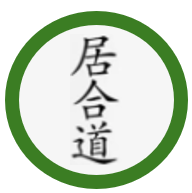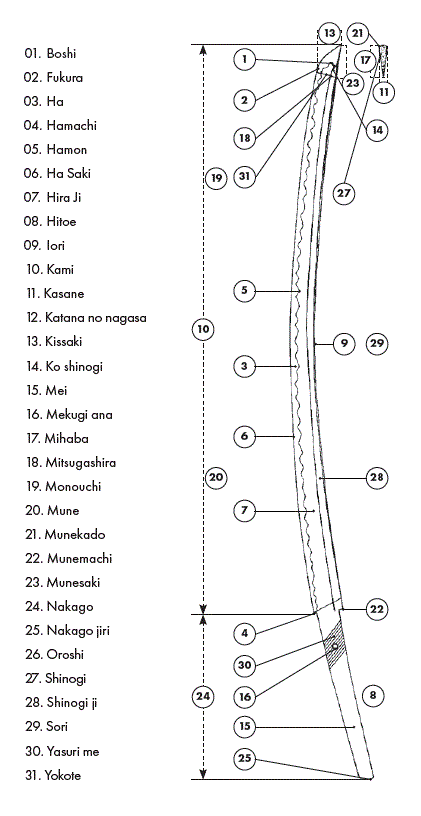GLOSSARY
Structure of the Nihon-To
(03) ● Ha - The actual cutting edge of the blade
(05) ● Hamon - The temper-line along the edge of the blade
(13) ● Kissaki - The tip point of the blade
(15) ● Mei - The signature of the maker, usually found on the Nakago
(16) ● Mekugi ana - The hole in the Nakago where the pin is inserted
(20) ● Mune - The back of the sword
(24) ● Nakago - Tang handle part of the blade
(27) ● Shinogi - The back ridge of the blade
(28) ● Shinogi Ji - The flat side of the blade
(29) ● Sori - The depth of curvature of the blade
(31) ● Yokote - The part of the blade tip point where the Boshi ends and the Monouchi begins.
(02) ● Habaki - Collar slipped on to the blade before placing Seppa and Tsuba
(03) ● Kashira - The butt end of the handle
(04) ● Koiguchi - The mouth of the scabbard
(05) ● Kojiri - The tip end of the scabbard
(07) ● Kurigata - The side knob of the scabbard where the Sageo is tied
(18) ● Makidome - The final knot of the binding near the end of the Tsuka
(08) ● Mekugi - Wooden (or other strong material) peg for securing the handle to the blade
(09) ● Menuki - Ornamental fittings found under the handle binding
(10) ● Sageo - Usually silk or cotton used for securing the scabbard to the Hakama
(11) ● Same - Rayskin used as a coating on the wooden handle under the binding
(12) ● Saya - Scabbard or sheath for holding the sword
(13) ● Seppa - Metal spacers placed either side of the Tsuba
(14) ● Tsuba - Sword guard
(15) ● Tsuka - Handle of the sword
GLOSSARY
General Terms
● Ashi Sabaki - Footwork or movement of the feet.
● Ayumi Ashi - Ordinary walking footwork, where both feet move naturally.
● Bokken - See Bokuto.
● Bokuto - A wooden shaped sword usually made from Japanese oak.
● Budo - Term given to generally mean all types of Japanese fighting arts.
● Chakuza - Sitting down from a standing posture. See also Seiza & Tate Hiza.
● Chudan No Kamae - One of the 5 basic postures of holding the sword in the middle position.
● Dojo - A hall or training place where students train in their respective disciplines.
● Enbu - The act of demonstrating Budo normally to an audience.
● Enzan No Metsuke - Literal meaning to gaze at distant mountains A term meaning to look at the whole, not something specific.
● Furi Oroshite - To swing the sword down from above the head.
● Gedan No Kamae - One of the 5 basic postures where the sword is lowered to just below the knee level.
● Ha - The cutting edge of the sword.
● Hakama - Skirt-like pleated trousers worn for practicing Japanese martial arts.
● Hanmi - A stance where the body is sideways on to the opponent.
● Hasso No Kamae - One of the 5 basic postures of holding the sword near the shoulder.
● Hasuji - The cutting line of the sword blade.
● Iaido - A form of sword fighting where drawing the blade quickly results in a single motion to defeat the enemy. Founded by Shigenobu Hayashizaki in the latter half of the 16th century, many schools were formed in the Edo period (1600- 1868). In 1956 the Iaido division was set up in the All Japan Kendo Federation, and in 1969 the All Japan Kendo Federation Iai Kata were established.
● Jodan No Kamae - One of the 5 basic postures; where the sword is held above the head.
● Kamae - General word or term given to mean posture or stance.
● Kata - Word given to mean form or set movement of techniques.
● Katana - Single edged weapon usually given to mean a Japanese sword.
● Katsuninken / Katsujinken - Zen Buddhist term given to mean «The Positive Way» of using the sword.
● Keito Shisei - Term used in Iaido to refer to the position whereby the sheathed sword is held on the left hip as compared with · Ken do which generally only uses Taito Shisei to describe the same position holding a Shinai.
● Ki Gamae - A state where the body is alert and ready to act in a moment.
● Kigurai - A state of commanding presence derived from confidence after much practice.
● Koiguchi - The mouth or opening of the sword sheath or Saya. Describing the similarity between that of the open mouth of a Japanese Koi carp.
● Kurai - A word given to mean the degree to which character is combined with skill.
● Metsuke - Correct positioning or looking with the eyes.
● Mizuochi - See Suigetsu.
● Morote - The action of using both hands to grip or hold the sword.
● Morote Zuki - The act of thrusting the sword using both hands.
● Mune - The back edge of the Japanese sword. Also called Mine.
● Nihon to - A general name given to mean a sword manufactured in a Japanese way.
● Noto - Act of placing the sword in the sheath. One of the basic movements of Iai.
● Obi - A long narrow sash worn around the waist to support the sword.
● Okuri Ashi - One of the basic kinds of footwork where the right foot is kept forward.
● Rei - Behavior and conduct showing respect and courtesy to others.
● Rei ho - Courtesy or politeness. Etiquette required throughout all Budo.
● Ryu ha - Literal meaning School. Usually meant to mean by a founder or I originator.
● Sage to - The standing posture holding a sword or Bokuto naturally at arm's length.
● Seiza - A way of sitting with the knees in line and the shins and the tops of the feet on the floor. The big toes of both feet should be adjacent to one another, and the buttocks resting on the heels. The back is straight, and the hands are placed on the upper part of the thighs with the fingers together. A formal way of sitting in Japan.
● Shinken - An actual or real sword with a cutting edge.
● Shinogi - On the blade of the sword, the raised ridge on the flat of the blade which runs from the sword guard to the tip point (Kissaki).
● Shinza - The shrine or revered place in a dojo or training hall.
● Shomen - A word meaning the front. For example Shomen E No Rei.
● Suigetsu - The depressed area below the sternum that is referred to as the pit of the stomach, solar plexus or Mizouchi.
● Tachi - A type of sword that is curved and generally longer than 60 em.
● Taito - The act of placing the sword in the Obi (sash or belt) or of placing the hand on the left hip when using a Bokuto.
● Tatehiza - Sitting on the left leg with the right knee raised off the floor.
● Teito - See Sageto.
● Tenouchi - The overall use of the hands when cutting, holding, tightening or loosening the grip on the handle.
● Tsuba - Sword guard; usually ornate, but essentially a piece of metal that is inserted between the hilt and the blade of the sword to protect the hands.
● Tsuba Moto - The area of a sword blade near or next to the sword guard.
● Tsuka - The hilt of a sword; the area which is usually gripped with the hands.
● Tsuka Kashira - The very end of the sword handle (pommel).
● Tsuku - To thrust at the throat, chest or solar plexus.
● Ukenagasu - To parry the striking opponents sword, deflecting it to the side with the Shinogi of one's own sword. The move is found in the third Kata Ukenagashi and the eleventh Kata Sou Giri.
● Waki No Kamae - One of the 5 basic postures where the sword is placed to the side and rear of the body, obscuring it from the front opponent's view.
● Waza - A motor skill which is gained through long hard training of cutting movements, and the learning of set techniques or Kata.
● Zanshin - The body posture and state of mind in which, even after cutting, one is alert and ready to respond instantly to any counterattack by the opponent. Generally speaking, after cutting, one should always be mindful of the distance between oneself and the opponent.
● Zarei - A bow made from the formal kneeling position.
GLOSSARY
Competition Terms
● Aka - Red-Color used to indicate court markings, flag color and one of the roles of competitors during Shiai.
● Fukushin - A sub referee who assists the main referee in judging matches. There are normally two in any Iaido competition, but having the same authority as the main referee in making or calling for decisions.
● Fusen Gachi - A win without actually fighting because the opponent did not appear or withdrew from the match.
● Gogi - the act of temporarily suspending a match for consultation. The referees hold a short meeting to decide if one or more of the players has made a critical error or if there is some doubt or uncertainty concerning the demonstration or application of technique.
● Hajime - A Japanese word used to mean start or begin.
● Hantei - The announcement by the main referee in calling for a match decision.
● Senshu - A Japanese word given to mean a competitor or entrant in a competition.
● Shiai - A match between individuals or teams that accords with defined regulations.
● Shiai Jikan - The time limit of a match. The standard time limit is six minutes, but may vary according to different tournaments and varying situations.
● Shiai Jo - A match court or area where matches are held.
● Shinpan - The act of judging the outcome of a match.
● Shinpan Cho - The chief judge who oversees all matches and the conduct of referees and players in the competition.
● Shinpan In - A referee.
● Shinpan Ki - Red and white flags used by the referees during matches.
● Shinpan Shunin - The court judge or referee. Usually appointed when there are two or more courts and assists the Shinpan Cho.
● Shiro - White-color used to indicate court markings, flag color and one of the roles of the competitors duiing Shiai.
● Shobu Ari - Literal meaning a victory. Announcement made to signal a decision and for the referees to lower their flags together at the same time.
● Shushin - The chief or main referee. Usually announces results of matches.
● Taikai - Literal meaning a great/big meeting. Commonly refers to competition.
● Taikai Kaicho - The chairman of the competition or tournament.
● Yame - A Japanese word meaning stop or halt.
● Yasume - A Japanese word meaning relax or stand easy.


